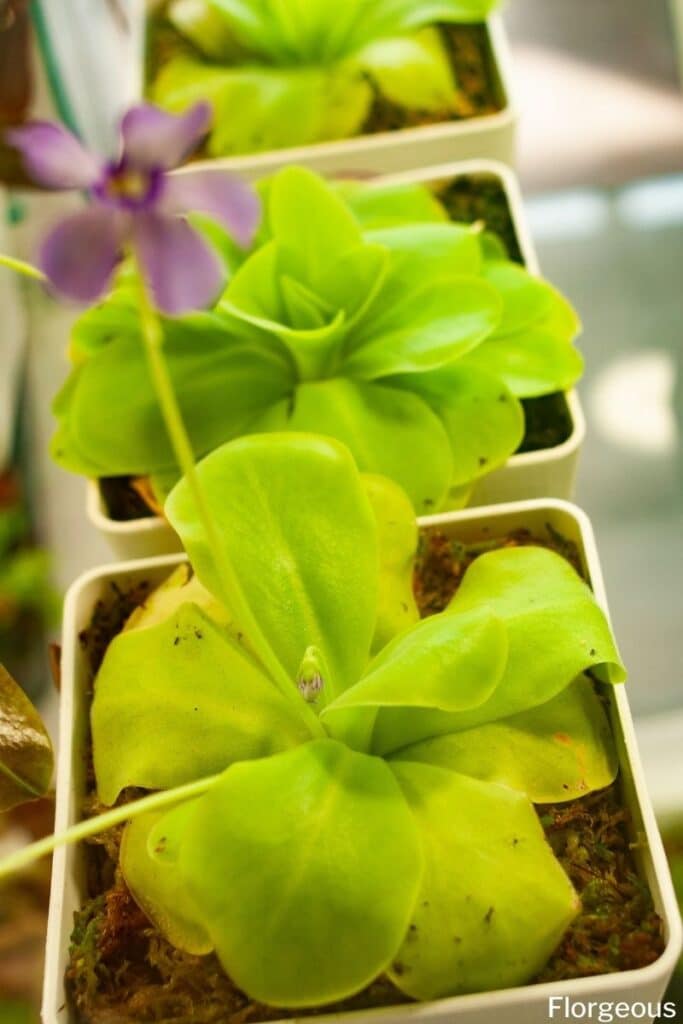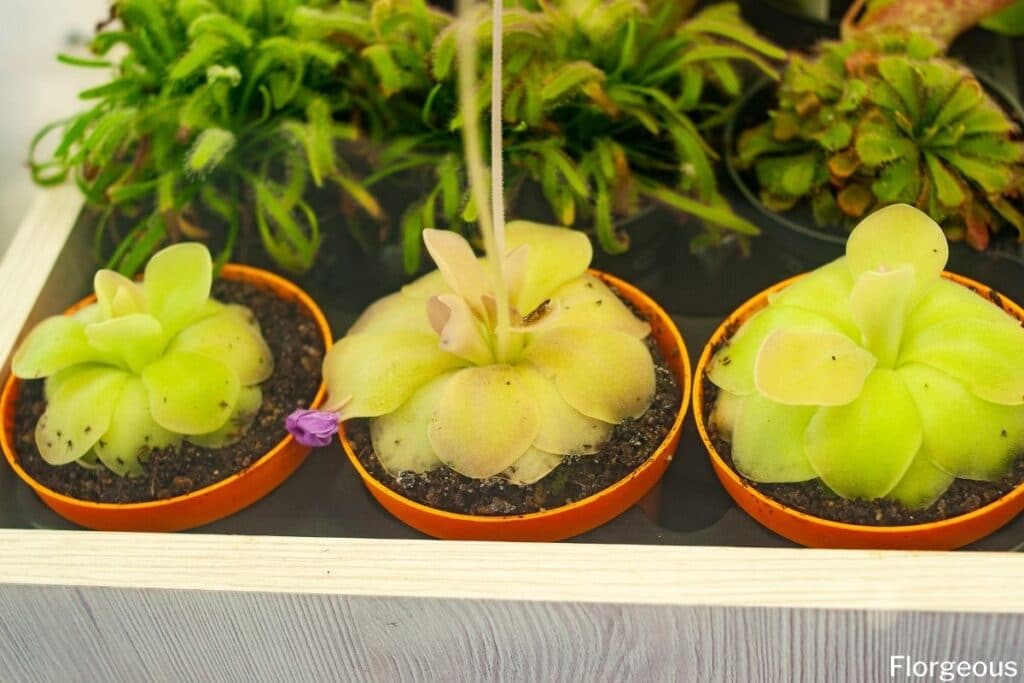Are you looking for a unique and fascinating addition to your plant collection? Look no further than the butterwort (Pinguicula), one of the common carnivorous plants. These plants are known for their ability to attract and trap insects with their greasy and sticky foliage.
In addition to their carnivorous tendencies, butterworts are also prized for their ornamental beauty, especially when they bloom.
If you’re interested in cultivating these intriguing plants, read on to learn more about how to grow and care for butterwort.
Plant Facts
| Scientific name | Pinguicula |
| Common names | Butterwort |
| Family | Lentibulariaceae |
| Plant Type | Houseplant |
| Height and Width | 2-3 in. tall (indoors), 2–3 in. wide (indoors) |
| Origin | Europe, North America, Asia, South and Central America |
| Flower colors | Yellow, pink, purple, or white |
| Foliage color | Pale green to yellow |
| Sun Exposure | Full sun to partial shade |
| Soil Type & pH | Moist, well-draining, and slightly acidic soil |
| Special features | Low maintenance, good for containers, ideal for outdoors |
How to Grow Butterwort
Butterwort plants are common all over the world, especially in south central Mexico or the southeastern United States, where there are more than 80 well-known species of the plant. These types of carnivorous plants are passive trappers, using a coating of insect-trapping resin on their leaves to trap its prey.
Typically, butterworts eat gnats, so while they can be grown indoors if you absolutely have to, most people will do best when they allow their butterwort to grow outside in its container during the summer months. It is dormant in the winter, anyway, so keeping mint indoors then is not a problem.
Butterwort is a perennial that will grow new rosettes each year, expanding its size as the plant gets larger. You can grow the plant fully outdoors, including during the winter, if you live in USDA zones 10 and 11.
These teeny-tiny plants are easy to miss if you aren’t paying attention. Their carnivorous leavesz are a yellow to green color and slightly greasy to the touch. The plant produces low rosettes and springtime flowers in shades of yellow, purple, pink, or white
The best environment for planting butterwort will be one that is somewhat boggy and with alkaline soil. The potting soil should be nutrient-poor. Remember, your plant will be catching insects for most of the nutrients it needs. These release nitrogen for the plant to use.
Additionally, remember not to let the soil dry out. If you grow in a container, it should have decent drainage and be placed in a mixture of sphagnum moss, vermiculite, and sand.
Propagation
The best and easiest way to propagate butterworts is to do so by seed. You can always plant by taking leaf cuttings or divisions, but growing from seed is the easiest way to grow butterworts. After all, that’s usually how they spread in the wild!
You can use a lightweight potting mixture in a container, filling the pot up to the top. Don’t breathe seeds – instead, just sow them on top of the moistened soil.
Let the tiny seeds germinate at high temperatures and high humidity (around 60to 80 degrees Fahrenheit and 90% humidity) for up to three weeks.
You should notice individual, miniature plants appearing at this time. Separate them into new pots.
If you’d rather propagate via division or leaf cuttings, you can do so by cutting leaves or dividing offsets. This is best done in the winter months.
Soil
Sandy, slightly acidic soil with good drainage is ideal for the butterwort plant. Don’t bother amending it with too many nutrients prior to planting – it prefers nutrient-poor soil and is often found in places like wet pine flatwoods, coastal plains, and pine savannas.
Pruning
You don’t need to do much in order to prune your butterwort. Most of the time, all you need to do is cut back any dead leaves you see in the early spring or late winter. Doing this will encourage new growth.
Repotting and Transplanting
Butterworts are small plants that rarely outgrow the confines of the containers in which they were originally planted (unless you started growing them in absurdly small pots!). However, since they form rosettes as they grow, you may wish to divide and repot your plant for multiple individual specimens.
To do this, wait until the dormancy period in the spring. This will give your plant the time it needs to bloom. Then, gently loosen the roots of the plant and separate them out, placing new parts in new containers. The new containers should contain a planting mixture of whole fiber sphagnum moss, peat moss, sharp sand, and coarse vermiculite.

How to Care for Butterworts
If you’re thinking about growing butterworts, it’s a good idea to do some research on the specific type you want to go to. That’s because temperate butterflies have different care requirements than tropical ones.
However, here are some general guidelines that apply to both kinds of plants.
Water
Watering is perhaps the single most important factor to consider when you are growing pinguicula. If you allow your butterwort to dry out, that can kill your plant. It needs to keep the soil moist.
It is also important that you consider the type of water you are using. Avoid using tap water because too much salt or various minerals can cause your plant to die.
Whenever possible, use pure water such as rainwater to irrigate your plant. If this isn’t an option, let your water sit out for a few hours before you use it to irrigate. This will allow some salts and chemicals to evaporate.
Sunlight
Grow your plant in full sunlight to partial shade. Get the most beautiful blooms from your tropical butterwort by growing it outside in part to full sun during the growing season.
Partial shade is acceptable but you may see fewer blooms. Plant your butterwort in a location where it will get direct bright light but a bit of shade at the hottest time of the day.
Temperature and Humidity
These carnivorous plants grow around the world so the best temperature will vary depending on the kind of plant you are growing. Temperate Pinguicula varieties thrive in cold winters with a period of dormancy, while warm temperate species can tolerate light frosts. Tropical butterworts, or Mexican butterworts, need things nice and hot – they grow well in environments like greenhouses and terrariums.
Most butterworts will go dormant in the winter, producing leaves that are no longer quite as carnivorous but are instead growing in a tighter pattern and with a more succulent-like texture. When the butterworts go dormant, you can stop watering. Here, providing adequate humidity is ideal, just misting them every now and then instead of providing full watering.
For the most part, temperate butterworts can tolerate temperatures of around 77 to 95 degrees in the summer (and around 50 to 65 degrees Fahrenheit in the winter). Tropical butterworts like things a little warmer. For both kinds, lower humidity is ideal during the winter months when the plant is dormant.
Fertilizer
Unlike most other carnivorous plants, you should not attempt to fertilize your butterwort plant. This plant is not a heavy feeder and adding too many nutrients can actually have adverse effects. Unlike other plants, the roots of the butterwort plant serve only to anchor the plant in the soil – they don’t actually absorb nutrients.
If you absolutely must fertilize (because of a suspected severe deficiency, for example) you can use a cactus fertilizer on tropical species only. If you fertilize, only apply it to the broad leaves.
Pest and diseases
As you might expect by their very nature, butterwort flowers tend to be mostly disease-free. After all, they’ll just eat any pests that come their way!
There are very few diseases that this plant suffers from, too. The only two to watch out for are browning heart disease and s center-to-edge rosette death. These diseases are most common among tropical, or “Mexican” varieties of Pinguicula.
Browning heart disease is most common on hot summer days and causes no new leaf growth and wilting. You might notice that the roots turn brown and die, too. It’s caused by a fungus and can be removed with a fungicide such as quintozene or benlate. Rosette edge-to-center-death is trickier to treat, since it doesn’t seem to be caused by a pathogen. Reducing abrupt swings in temperature seem to be the only way to prevent it.
Common Varieties and Cultivars
There are several common varieties and cultivars of butterworts that you can grow. Most of the time, the different forms of butterworts are categorized based on the climate in which they grow and then further divided based on various characteristics that they possess.
The four main groups of butterworts are:
- Heterophyllous tropical species
- Homophilous Tropical species
- Heterophyllous temperate species
- Homophilous temperate species
The phrases “heterophyllous” and “homophilous” refer to the patterns of roosters and leaves on the different plants. The temperate species of butterworts are the most common, with these cultivars most commonly found at nurseries:
- P. moranensis ‘G’
- P. ‘True Blue’
- P. gigantea
- P. grandiflora
- P. laueana
- P. ehlersiae
- P. esseriana
- P. jaumavensis
- P. immaculata
- P. kondoi
FAQs
How often do you water butterwort?
Butterworts (Pinguicula) prefer to be kept consistently moist but not waterlogged. Water them when the top inch of the soil feels dry, usually every 1-2 weeks depending on environmental conditions. It’s important to avoid overwatering, which can lead to root rot.
How much light do butterworts need?
Butterworts thrive in bright, indirect light or partial sun. They can be placed on a windowsill where they receive filtered sunlight, but avoid exposing them to intense, direct sun for extended periods.
Are butterworts pet safe?
Butterworts are generally considered pet-safe as they do not pose significant toxicity risks. However, as a precaution, it’s advisable to keep them out of reach of curious pets to prevent any unintended ingestion.
Conclusion
Move Over, venus fly trap! There’s a new carnivorous plant to consider growing. If you want to grow a houseplant that will truly astound your family and friends, you’ve got to consider these butterwort care tips. Good luck!
For more houseplants to grow, check our list.







